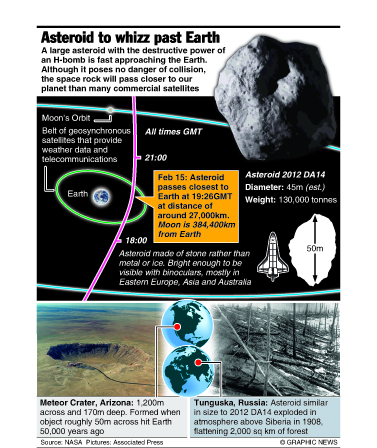Sunday Times 2
Close shave for Earth as asteroid is set to whizz by
View(s):By Kate Bevan
Planet Earth is set to have a very close encounter with an asteroid the day after Valentine’s Day.
The asteroid – which goes by the catchy name of 2012 DA14 – will miss our home planet by just 17,200 miles, which is a very near miss in space terms.
The asteroid, which is about 150ft across, will come closer to Earth than the ring of geosynchronous satellites, which are in orbit about 22,200 miles above the Earth.
Although the asteroid is small, if it were on a collision course with Earth, it would produce the equivalent of 2.5 megatons of TNT.
And this is just one of some 500,000 rocks circling the Earth.
The good news is that scientists say that that isn’t enough to wipe out life on the planet – but it could wipe out a city the size of Greater London.
However, a miss is as good as a mile, and unless you’re specifically looking for it, you almost certainly won’t see the asteroid.
NASA says that it won’t be bright enough to see with the naked eye, but that a good pair of binoculars or a telescope should be able to  pick it out.
pick it out.
On the 15th, said NASA, the asteroid will travel rapidly from the southern evening sky into the northern morning sky, with its closest Earth approach occurring about 19:26 UTC when it will achieve a magnitude of less than seven, which is somewhat fainter than naked eye visibility.
About four minutes after its Earth close approach, there is a good chance it will pass into the Earth’s shadow for about 18 minutes or so before reappearing from the eclipse.
When travelling rapidly into the northern morning sky, 2012 DA14 will quickly fade in brightness.
The best view for astronomers will be from Indonesia, says NASA, while stargazers in Eastern Europe, Asia and Australia should also be able to get a good look at the space rock as it whizzes past us at a speed of 17,400mph.
The asteroid was discovered only last year, by astronomers in southern Spain.
The team was operating from the La Sagra Sky Survey observatory near Granada in Spain. The observatory uses automated telescopes to track small asteroids and comets.
2012 DA14 was discovered after the astronomers decided to search areas of the sky where asteroids are not usually seen.
Its orbital period around the sun is very close to our own, at 368 days, and it has made a close approach every year. This year’s is the closest, say scientists – and the good news is that this is the closest it will get to Earth for at least three decades.
Dr Gerhard Drolshagen, a near-Earth object observer from the European Space Agency’s Space Situational Awareness (SSA) office, said: ‘In future times the possibility of a collision cannot be completely excluded. It is highly unlikely, but the chance is greater than zero.’
The asteroid’s next very close shave with Earth will be in 2046, when it will squeak by us at a distance of 37,000 miles.
And there’s another close encounter in 97 years’ time, on February 16 2110, when the chance that it will hit the Earth is 1 in 7,692,308,000.
© Daily Mail, London
| WHAT HAPPENS WHEN AN ASTEROID HITS: THE 1908 TUNGUSKA EVENT On June 30 1908, in a remote part of Russia, a fireball was seen streaking across the daytime sky. |
Follow @timesonlinelk
comments powered by Disqus


















